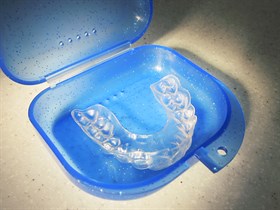Braces, Retainers and Dental Health
Straightening teeth is known as orthodontics, and is needed as
part of orthognathic treatment before and after surgery.
Orthodontic braces are used to move the teeth into the correct
positions so that after the surgery the teeth in the upper and
lower jaw meet. The braces are not only used to move the
teeth before surgery but also allow the bite to be finely adjusted
afterwards.
Fixed braces commonly known as 'train-track' braces are
typically worn for 18 months to 2 years before the surgery and then
kept on up to 4-9 months afterwards. This time can vary
depending on how straight the teeth are beforehand and the amount
the jaws need to be moved.
Above: A patient
having their brace adjusted
Treatment is lengthened by missed appointments and any breakages
of the brace (see below: Brace Breakages and
Emergencies). If you can't attend an appointment,
please contact the department and rearrange your appointment, so
not to delay your treatment.
Keeping your brace clean and your teeth and gums
healthy
Interdental (in between the teeth) brushes are
essential to clean in between the teeth, around the brackets and
under the wire as shown in the video below. If you do not
brush your teeth, and you eat the wrong diet, your treatment
will be abandoned and the braces removed. This is to
prevent damage to the teeth (e.g. marks and decay) or gum
disease.
Above: A large
interdental brush used to clean underneath the wire
- Do brush your teeth for 2-3 minutes twice a
day with a fluoride tooth paste.
- Do use an electric toothbrush if you like
using them. They will not break your brace. Ones with a
built in timer and small toothbrush head are helpful.
- Do use sugar-free chewing gum after meals to
help reduce tooth decay.
- Do cut down or stop fizzy, acidic drinks and
sweet sticky foods as this will cause decay and dissolve the enamel
around the brackets leading to square marks on the teeth once the
brace has been removed.
- Do not bite and chew hard foods
e.g. apples or crusty bread as this may break your brace.
There are leaflets on the clinic which will give you diet
and brushing advice. Please ask your dental nurse and they
will give you one.
Brace breakages & Emergency
appointments
If your brace breaks don't worry. If it is less than 2
weeks before your next appointment with the orthodontist, and you
are not in pain then it is ok to wait for it to be fixed. If
the brace breaks in the weeks following surgery then contact the
department as soon as possible. Emergency appointment slots
are available Monday - Friday and are only available by contacting
the department to book a slot (Tel: 0117 342 4350
or 0117 342 4338). If the brace is sharp,
use the wax to keep your mouth comfortable.
Elastics
After surgery you will have to wear elastics to settle your new
bite and prevent you from over stretching your jaw muscles.
Your surgeon and orthodontist will demonstrate how to put them on
and where. It is important you put them on in the correct
place. If you are not sure ask the orthodontist or surgeon to
draw how on the back of the elastics bag. They should be
changed daily.
How to fit your elastics
A plastic hook (shown below) may be given to you to make placing
the elastics easier in the first few days or weeks after
surgery when you are swollen and the stiches are sore (see
photo below: Patient 1 week after surgery).
Tweezers can also be used.

Above: A patient fitting
their elastics
Retainers
After the braces are removed all patients will receive clear
plastic removable retainers (pictured below left) and in some
cases also a fixed retainer (pictured below right).
Retainers are as important as the braces and surgery.
They will keep your teeth straight and if you want to
maintain the finished result you should wear them on a part-time
basis for life. Your orthodontist will advise you
how often to wear the removable retainer.
If you lose your retainers inform your dentist or your
orthodontist straight away so you can get a new retainer made
before the teeth move. There is a fee
for replacement retainers if you lose them or want a new
set made, so take care of them.
How to clean your retainer
- Do gently clean your retainer with cold
water and liquid soap or mouthwash daily
- Do use a sterilising tablet/liquid
occasionally to keep your retainer bacteria free and cleaner
for longer
- Do not use tooth paste to clean your
retainer
- Do not use hot water as it will melt the
plastic.


Dental treatment
You must have good dental health for orthodontic treatment.
Regular check-ups every 6 months with your dentist are
essential as the surgeon and orthodontist will not be
routinely checking for tooth decay. It is advised to book a
scale every 6 months and just before the date of your surgery.